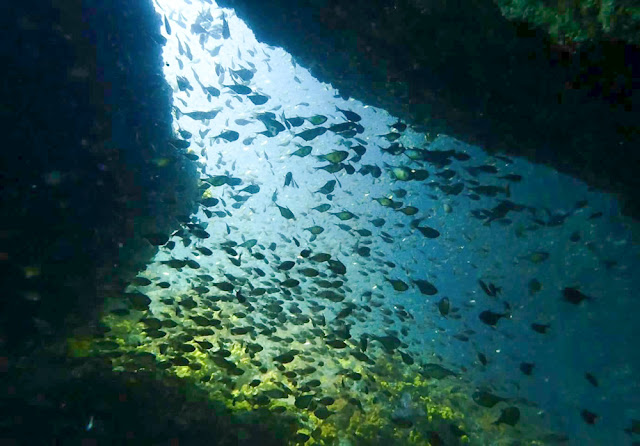BLACK ROCK (MERGUI DIVE SITE)
Black Rock - An 80 metre wide islet, Black Rock stands in a northwest to southeast position, with steep banks all around, and with a wall on its west and south west sides. Many divers' favourite spot in the Mergui Archipelago, Black Rock will have your your heart pounding from spectacular passes of whitetips, silvertips, and black-tip sharks.
Standing alone in the Andaman Sea 100 miles north west of the Thai-Burmese border town of Kawthaung, Black Rock acts as a natural fish magnet and is just as famous for its incredible schools of mobula rays. Then there's the majestic encounters with manta rays and eagle rays soaring above and around you off the deep north western corner, and huge marble stingrays and leopard sharks on the sandy bottom.
Diving down on to the boulder slopes to the south you'll find sprawling carpets of brown disc anemones (Corallimopharian Discosoma) and purple soft corals (Dendronephthya). Home amongst the lower boulders is the granddaddy of all great barracudas. Over 1½ metres long, this thick set monster is so huge it ignores divers, intent instead on receiving dental surgery from the cleaner wrasse. Its scars bare testimony to many a bruising encounter.
Soft corals are most dense in the deeper south west sections corner of Black Rock. This colourful area includes orange cup corals, feather stars, gorgonian sea fans, and tiger striped anemones that cover the large boulders. Spotted hawkfish can be found in the sea fans. Black spotted pufferfish seem too lazy to swim here, preferring to just rest on a rock ledge. Blue ringed angelfish swim around the rocks. This is a good spot for seeing reef sharks or even bull sharks.
Head to the shallower eastern section for mantis shrimp, red swimmer crabs and large hermit crabs. Moray eels including zebra and white mouthed morays can be seen plus a large number of cowrie shells. Also dotted on the rocks are the unusual white hairy urchins (Lovenia Elongata).
Explore the wall for blue, yellow, green and orange soft tube corals, and the banks for hunting big-eye trevally, pompano and banded sea snakes. Rainbow runners pass by in fast moving schools, whereas long fin batfish pass at a more leisurely pace.
Please do take note that currents can be strong and terminally downward, particularly on the deeper sides of the islet. Moving beyond the shelter of the rocks on the island's east and west tips can make it very hard to get back to the site again. However if you stay close to the rocks this doesn't have to be a difficult dive.
Altogether, Black Rock is a truly awesome Burma dive site. Not to be missed!




Comments
Post a Comment